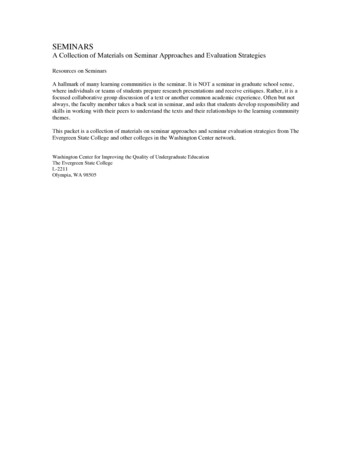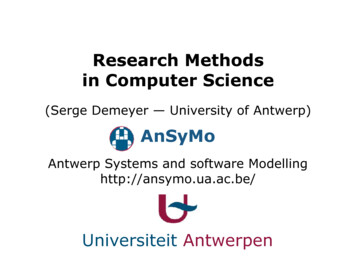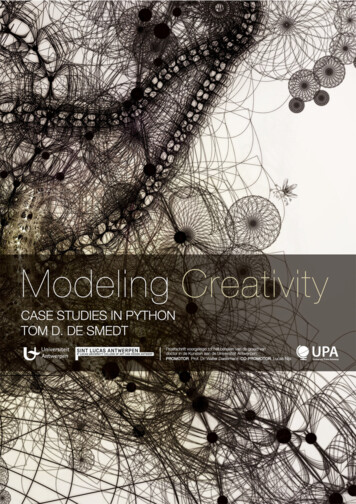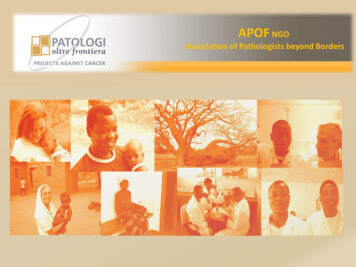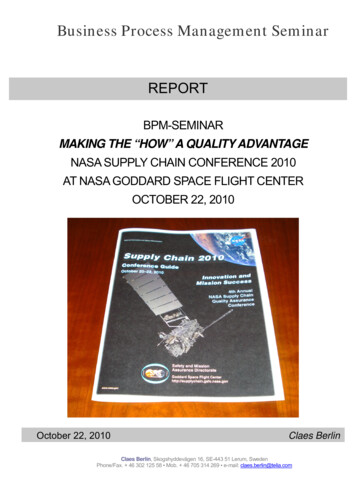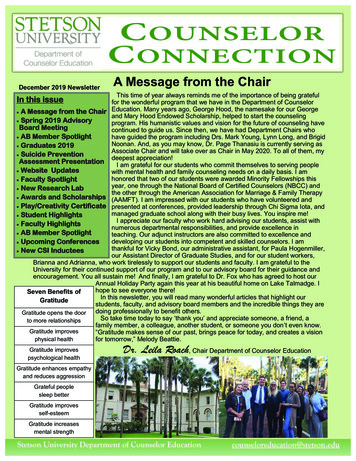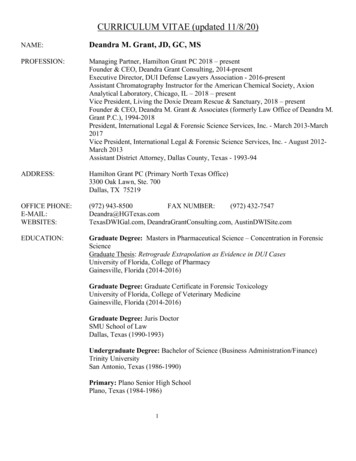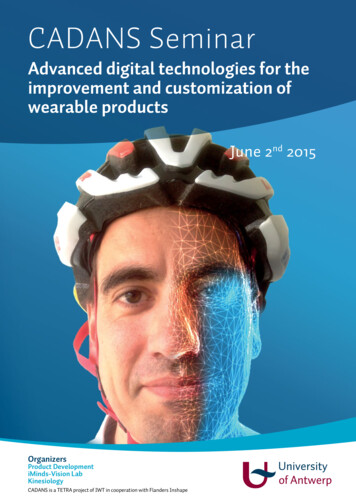
Transcription
CADANS SeminarAdvanced digital technologies for theimprovement and customization ofwearable productsJune 2nd 2015OrganizersProduct DevelopmentiMinds-Vision LabKinesiologyCADANS is a TETRA project of IWT in cooperation with Flanders Inshape
CADANS SeminarAdvanced digital technologies forthe improvement and customizationof wearable productsJune 2nd 2015RegistrationRegistration fee: 75 per attendeeOnline registration :http://cadans.uantwerpen.be/?q cadans-seminar-2015Subscription before: May 31th 2015OrganizersProduct DevelopmentiMinds-Vision LabKinesiologyLocationUniversity of AntwerpDivision of product developmentAmbtmanstraat 1, 2000 AntwerpTopicThe design of products that closely interact with the human body, suchas furniture, clothing, orthotics, and protective gear, requires a thorough understanding of the variation in human anatomy. Anthropometry– measurement of man – is an important tool in the design process toensure safe, confortable, and functional products. Emerging technologiesto digitally capture human body data, e.g. via 3D scanning, offer far richerdata compared to the traditional tape measure and open up opportunitiesin adding unique value through comfort improvement or personalisation.The application of these new technologies is, however, still perceived aschallenging. This seminar provides an in-depth look in state-of-the-art 3Danthropometry in industry and academics with real-world cases. All SMEs,large companies, and academic researchers are cordially invited to join usin making this an inspiring one-day seminar.The morning session focuses on industrial applications and the afternoon sessionfocuses on recent advancements in related scientific research.
Morning sessionapplications for on & coffee @ central hall09:00Welcome & introductionToon Huysmans – Post-doc researcher at iMinds Vision Lab& copromotor CADANS project University of Antwerp09:1511:05By combining expertise in 3D Printing and design automation with RScan’sleading dynamic measurement footscan solutions, RSPrint will create theworld’s first dynamic 3D printed insoles, customized to support the everymove of an individual. In that context, the speaker will address the following questions: What is the added value of additive manufacturing for mass production? What is the role of expert knowledge and ‘classic’ expert knowledge in a3D-printing environment? What are threats & opportunities for existing industries and threats &opportunities for additive manufacturing?Keynote Exploitation of 3D based resourcesAlfredo Ballester – IBV-Biomechanics institute of Valencia (ES)IBV is a technological centre that studies the behaviour of the human bodyand its interaction with products, environments and services. The speakerpresents a completed representative national database of true 3D bodyshapes (ES; including man, women and children) and state-of-the-art datafor Europe (Eurofit project). Further a tool to apply these data is presented(Hypercliq service within EUROFIT). Applications for proper fit and functioning are discussed (Iturri), as well as application in orthopaedics (Össurknee bracing). Closing topic is the advancements on human motion andshape generator (EASY project).10:15Coffee break10:35Bivolino’s patented biometric sizing technologyGaby Ratajczak - Bivolino (BE)Bivolino.com (BE) is an EU cross-border operating (b2c) e-shop for made tomeasure shirts for men & women. Bivolino.com controls the entire digitalsupply-chain with integrated manufacturing plants. The patented biometric sizing technology is presented, that makes it possible to obtain a goodfit without the use of the measurement tape. Bivolino collaborates withmajor EU department stores like De Bijenkorf, 3Suisses, Tchibo, El CorteIngles, Neckermann, Amazon, High&Mighty and Debenhams. Finally itis presented how through BivolinoServices (a collaborative platform fore-custom fit apparel), its 3D visualization and biometric sizing technologyis licensed to e-tailers: WE-fashion, Marks and Spencer, Baur (Otto-group)Customization and fitting and how it affects the production processTom Peeters - Marketing Specialist-RS Print (BE)11:35CADANS methodology & closing remarksJochen Vleugels & Toon Huysmans - CADANS University of Antwerp (BE)In this project, state-of-the-art processing techniques are employed tostructure 3D-scan databases into 3D statistical anthropometric modelsthat provide a concise parameterization of the 3D human body shape withanthropometric parameters. These models are then made available to theproduct developer: online and as a plugin in standard CAD-software.The online tool provides an easy way to generate human head shapes bestfitting according to given measurements. Then products can be made thatfit these models accordingly, multiple models can be made e.g. to analyzethe shape differences in varying head sizes.The CAD plugin provides the similar functionality but integrated in a SolidWorks environment. This means that products can be designed directly on3D body shapes and that there is a dynamic link between the drawing andthe body shape. This allows one to easily adapt the CAD drawing for newbody shapes, e.g. obtained from personal measurements. Generation ofshapes and sizing systems could become a valuable tool to design betterfitting and mass-customized products.12:00 - 13:00Network lunch
CADANS DemoRoomMU.A.2.07Afternoon sessionrelated researchSchedulebetween 12:00-16:00during lunch andcoffee breaksDemo: Cadans Web-based tool and SolidWorks PluginJochen Vleugels and Rob Linders – University of Antwerp (BE)AuditoriumMU.A.2.03Schedule13:00In the demonstration of the CADANS plugin we will show what we arecapable of as of so far with a simple product example and show our step bystep method of helping designers and developers throughout the process.-What are threats & opportunities for existing industries and threats &opportunities for additive manufacturing?Deriving design specifications from shape modelsDaniel Lacko - doctoral student University of Antwerp and KULeuven, multidisciplinary project Product development, physics and Neurophysiology- (BE)CAD-related conferences and journals are featuring more and more papersabout shape models and 3D anthropometry. However, it is still unclearhow these models should be used for ergonomic design. Designers needto be able not only to predict or adapt surface representations of the body,but also to extract useful specifications out of the models. In this presentation, it is shown how a shape model of the human scalp can be usedto create both a one-size-fits-all brain-computer interface headset anda new sizing system for bicycle helmets. Both methods have been testedthrough proof-of-concept prototypes. Experiments have shown that bothproducts fit their target population better than their traditionally designedcounterparts. After this talk, you will be ready to start implementing 3Danthropometry in your own design process and enjoy the many benefits itoffers complementary to traditional design.13:30From motion to M2OCEAN: Motion capturing and motor controlAnn Hallemans – assistant professor University of Antwerp& project coordinator of M2OCEAN (BE)In order to get a full image of the progress and control of movements,kinematic data obtained from optometric and/or electromagnetic movement registration have to be combined with force measurements, electromyography and the registration of foot pressure, possibly also withhigh-speed detail kinematics. M2OCEAN is a fully equipped state-ofthe-art research center enabling competition with the best in the field. InM2OCEAN research is performed in humans, from children to elderly, inphysiological, pathological and specific conditions. Major topics of interestare balance and postural control locomotion and sensori-motor control ofvoluntary movements. During this talk the research infrastructure, possibilities and example projects will be discussed, which could complementthe development of statistical shape models.
14:00Smartfit measurement campaign 2012 – 2013: results and implementationJoris Cools – research fellow smartfit project HoGent (BE)With the financial support of the Agency for Innovation through Science andTechnology (IWT), over the last two years University College Ghent carriedout a measurement campaign for a systematic mapping of Flemish humanbody measures. The measurements and body shapes of the Belgian population were mapped using high-tech 3D body scanners. The results of thiscampaign led to defining four new body measurement tables for women infour age categories and six new body measurement tables for men in threeage categories.14:30Coffee break15:00Thermal comfort and fitGuido De Bruyne – associate professor ergonomics, University of Antwerp (BE)In this talk a first link between statistical models and physical properties isexploited that might serve as an onset to build enriched statistical models.The presented research is confined to modeling and verification of thermalcomfort and might lead to predictions of local thermal discomfort and adesign methodology to optimize thermal comfort.15:30Human Body ModelingFemke Danckaers – doctoral fellow iMinds Vision Lab (BE)The human body appears in many shapes and sizes. For ergonomic products, it is important that they have an accurate fit to ensure an optimalcomfort. Traditional product development techniques are based on 1Dmeasurements of the body. By building a 3D statistical shape model of thebody, representing mean shape and the variability inside the population,there is a realm of information available to improve the process of new product development. Such a shape model is build by constructing meaningfulcorrespondences between the surfaces and applying principal componentanalysis (PCA) on the collection of corresponded surfaces, to generate a representative model for the population. The shape model will be implementedin a CAD environment as a virtual mannequin, so it can be used to validateand optimize designs. The virtual mannequin will be fully adjustable, bothin pose and in body shape. This will lead to more ergonomic products and areduction of the design time.16:00Closing remarksStijn Verwulgen – professor University of Antwerp (BE)For more information,feel free to contactToon Huysmanstoon.huysmans@uantwerpen.be 32 (0) 3 265 24 72iMinds-Vision LabDepartment of PhysicsUniversity of Antwerp (CDE)Universiteitsplein 1 (N1.19)B-2610 Antwerp, Belgium
IWT TETRA Project CADANS 2014-2016A CAD Platform for 3D Statistic-Anthropometric DesignDesign of Wearable ProductsThe human body is a complex shape with many variations of which a thorough understandingis needed in order to design wearable products like protective gear, head-sets, sports clothing,and orthotics, that are both functional and ergonomic. Current design approaches, relying onlyon 1D anthropometry and unrealistic, linearly scaled ISO-mannequins, require many prototyping and testing iterations. With the uprising of 3D scanning technology, however, an enormousamount of 3D data becomes available for the product developer. Unfortunately, it is not yetclear how this wealth of information can be leveraged for improving their products. CADANSwill solve this.CADANS Technology & InnovationIn this project, state-of-the-art processing techniques are employed to structure 3D-scan databases into 3D statistical anthropometric models that provide a concise parameterization of the3D human body shape with anthropometric parameters. These models are then made available to the product developer in standard CAD-software where they can be used for: quantitative and qualitative exploration of 3D shape and size variation within a target population; devising product and target-group specific sizing systems, e.g. one-size-fits-all or N-sizes-fit-all; dynamic linking of CAD designs to 3D shape models for easy mass-customization of the product.What is IWT TETRA?A TETRA-project is focused at translating scientific knowledge to the everyday practice ofFlemish enterprises and thereby increasing innovation potential to ensure that they candevelop new products, services or processes faster. The project is executed by a consortium ofacademic research groups and funded by IWT (92.5%). Companies that can benefit from theproject results are invited to join the user committee and to actively support the project (7.5%).As a user committee member you are granted exclusive access to all results during the projectand you have the opportunity to steer the project, provide use-cases to optimize your productsor workflow, participate in project meetings, etc. For more information contact us.ProjectPartnersUserCommi0eeFundingPartner
3D body shapes and that there is a dynamic link between the drawing and the body shape. This allows one to easily adapt the CAD drawing for new body shapes, e.g. obtained from personal measurements. Generation of shapes and sizing systems could become a valuable tool to design better fitting and mass-customized products. Network lunch 08:30 09: .

